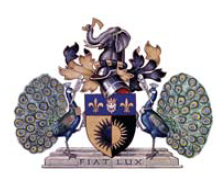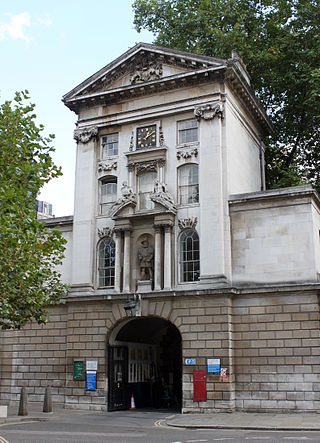The University of Brighton is a public university based on four campuses in Brighton and Eastbourne on the south coast of England. Its roots can be traced back to 1858 when the Brighton School of Art was opened in the Royal Pavilion. It achieved university status in 1992.

The Thomas Coram Foundation for Children is a large children's charity in London which uses the working name Coram.

Dartington Hall in Dartington, near Totnes, Devon, England, is an historic house and country estate of 1,200 acres (4.9 km2) dating from medieval times. The group of late 14th century buildings are Grade I listed; described in Pevsner's Buildings of England as "one of the most spectacular surviving domestic buildings of late Medieval England", along with Haddon Hall and Wingfield Manor. The medieval buildings are grouped around a huge courtyard; the largest built for a private residence before the 16th Century, and the Great Hall itself is the finest of its date in England. The west range of the courtyard is regarded nationally as one of the most notable examples of a range of medieval lodgings. The medieval buildings were restored from 1926 to 1938.

The University of Roehampton, London, formerly Roehampton Institute of Higher Education, is a public university in the United Kingdom, situated on three major sites in Roehampton, in the London Borough of Wandsworth. The University traces its roots to four institutions founded in the 19th century, which today make up to university's constituent colleges, around which student accommodation is centred: Digby Stuart College, Froebel College, Southlands College and Whitelands College.

Moorfields Eye Hospital is a specialist NHS eye hospital in Finsbury in the London Borough of Islington in London, England run by Moorfields Eye Hospital NHS Foundation Trust. Together with the UCL Institute of Ophthalmology, which is adjacent to the hospital, it is the oldest and largest centre for ophthalmic treatment, teaching and research in Europe.

The Royal London Hospital is a large teaching hospital in Whitechapel in the London Borough of Tower Hamlets. It is part of Barts Health NHS Trust. It provides district general hospital services for the City of London and Tower Hamlets and specialist tertiary care services for patients from across London and elsewhere. The current hospital building has 845 beds and 34 wards. It opened in February 2012.

The Prince's Trust is a United Kingdom-based charity founded in 1976 by King Charles III to help vulnerable young people get their lives on track. It supports 11-to-30-year-olds who are unemployed or struggling at school and at risk of exclusion. Many of the young people helped by the trust face issues such as homelessness, mental health problems, or trouble with the law.

St Bartholomew's Hospital, commonly known as Barts, is a teaching hospital located in the City of London. It was founded in 1123 and is currently run by Barts Health NHS Trust.

Pehr Henrik Ling pioneered the teaching of physical education in Sweden. Ling is credited as the father of Swedish massage.
Bankside Open Spaces Trust (BOST) is a horticulture, gardening and management of urban open space charity, based in Bankside, the southern bank by the River Thames, Southwark, Central London, England. BOST works local communities and organisations in London, such as Tate Modern community garden, to improve, create and enjoy the parks, gardens, green spaces, and, passive and active recreation areas.

Stratford Circus was a contemporary performing arts venue in Stratford in the London Borough of Newham, east London. It was designed by Levitt Bernstein architects and built with funding from the National Lottery, and had been operated by the Stratford Arts Trust charity since 2011.

Radio Harrow is a local charity radio station for Harrow, London, England, promoting health and wellbeing within the local community through its broadcasting and NHS befriending service. Registered charity number 1161203.

A gym, short for gymnasium, is an indoor venue for exercise and sports. The word is derived from the ancient Greek term "gymnasion". They are commonly found in athletic and fitness centers, and as activity and learning spaces in educational institutions. "Gym" is also slang for "fitness centre", which is often an area for indoor recreation. A "gym" may include or describe adjacent open air areas as well. In Western countries, "gyms" often describe places with indoor or outdoor courts for basketball, hockey, tennis, boxing or wrestling, and with equipment and machines used for physical development training, or to do exercises. In many European countries, Gymnasium also can describe a secondary school that prepares students for higher education at a university, with or without the presence of athletic courts, fields, or equipment.

Sunrise in Baku was an international fashion project held on 28 February 2009 in London, England. The project was part of a series of philanthropic events organised by KPK Entertainment Group in the United Kingdom and aimed to raise funds and awareness for the UK-based charity organisation ABC Trust Foundation - Action for Children of Brazil. The initiative, whose proceedings contributed towards the establishment of a primary school in Brazil, was supported by Azerbaijan Embassy, Brazil Embassy and the High Commission of Cyprus in London.

The Cassel Hospital is a psychiatric facility in a Grade II listed building at 1 Ham Common, Richmond, Ham in the London Borough of Richmond upon Thames. It is run by the West London NHS Trust.
Rajashree Birla is an Indian philanthropist. She is the wife of the late Aditya Birla. After her husband's death in 1995, Rajashree began working in CSR and charity sectors, developing a large philanthropic organization funded by her family. In 2011, the Government of India honoured her with the Padma Bhushan, the third highest civilian award, for her services to society.

Fitness culture is a sociocultural phenomenon surrounding exercise and physical fitness. It is usually associated with gym culture, as doing physical exercises in locations such as gyms, wellness centres and health clubs is a popular activity. An international survey found that more than 27% of world total adult population attends fitness centres, and that 61% of regular exercisers are currently doing "gym-type" activities. Getting and maintaining physical fitness has been shown to benefit individuals' inner and outer health. Fitness culture has become highly promoted through modern technology and from the rising popularity of social media platforms.
Brathay Trust is a youth-development charity with its head office and residential centre based at Brathay in Cumbria, England. Founded in 1946 by Francis C. Scott, the charity is based at the Brathay Hall and estate near the town of Ambleside. The charity's mission is to transform the lives of young people in need. Methods include outdoor education and experiential learning, but also delivers people and organisation development courses for adults. In 2007, the trust began holding the Brathay Windermere Marathon, a now annual charity marathon.
The National Centre for Sport and Exercise Medicine (NCSEM) is an Olympic legacy project delivering education, research and clinical services in sport, exercise and physical activity from three hubs across England. It is a collaboration of universities, healthcare trusts, local authorities and private and voluntary sector organisations.
The Queen Elizabeth Hospital Charity was created mainly to support medical and health research, and to fund and encourage excellence in healthcare for patients and their care givers, wholly or mainly through the services provided by University Hospital Birmingham NHS Foundation Trust. It raises money for campaigns that are over and above what the NHS can provide. QEH Charity was formed in 2001, however, there has been an official charity associated with the Queen Elizabeth Hospital since the creation of the NHS in 1948. QEH became independent in April 2016.
















